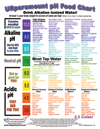Alkalize, energize, detoxify,
FEEL BETTER- drink
high pH alkaline water
and use frequency healing
from the
for optimal wellness
and anti-aging!
Spirulina The Power Food
The first thing to pop into your mind when someone says "protein" probably isn't algae, but it should be. Spirulina is the common name given to the variety of blue-green algae Spirulina platenis. The name Spirulina is derived from the Latin word for spiral and describes the micro algae's cell structure of spiraling filaments. Recognized by ancient cultures as a good source of nutrition, Spirulina has only recently begun to have the support it deserves in our society.
Spirulina, though related to the sea kelp algae, is not a sea plant. The organism thrives in fresh water ponds and lakes that are considerably more alkaline than average. This ability to thrive in waters with a pH balance of 8 to 11 and temperatures of 85 [degrees] to 112 [degrees] ensures the purity of the Spirulina; no other organism can survive in the waters in which it thrives. The fact that Spirulina grows and survives in high temperatures is assurance to the consumer that it can retain its nutritional value during storage or processing.
It is doubtful the Aztecs knew the nutritional content of Spirulina, but they certainly understood its value. They were discovered supplementing their diets with little cakes called "tecuitlat1" made from dried algae. The Mayans were also known to use Spirulina in their diets, as well as the Kanembu tribes of Chad and Niger. Diche as the cakes were called, were made of Spirulina collected form the edges of a lake and dried in the sun.
Spirulina contains the correct amount of all eight essential amino acids, and 10 of the 12 non-essentials, which qualifies it as a complete protein. In fact, Spirulina is 65 to 70 percent protein. Two and a half times the Recommended Daily Allowance (RDA) of vitamin B12 (cyanocobalamin) can be found in a single teaspoon of spirulina. Two heaping teaspoons of Spirulina contain 70 percent of the RDA for vitamin B1 (thiamine), 50 percent for B2 (riboflavin) and 12 percent for B3 (niacin). Other vitamins and minerals abundant in Spirulina are: B5 (pantothenic acid), B6 (pyridoxine), biotin, folicin, inositol, and beta-carotene as well as 20 percent of the RDA for vitamin E, 58 percent for iron, 16 percent for phosphorus, 8 percent for magnesium and 4 percent for zinc.
High in nutrition but low in calories, Spirulina is only 7 percent lipid, made up of linoleic, linolenic and arachidonic acids. These fatty acids promote regulation of cholesterol levels and help produce the hormonal regulators of blood pressure. Because of its high nutritive value and low calorie count, Spirulina is used in weight control programs to curb hunger. It is a concentrated raw food easily assimilated by the body so it actually satisfies hunger. Several health clinics have reported that a few grams of Spirulina taken an hour before mealtime reduced the appetite and allowed greater control over food intake.
If you currently use fasting to cleanse your system, you might consider supplementing your fast with Spirulina because it provides concentrated nutrients without bulk intake and eases intestinal discomfort associated with fasting.
Spirulina is easy to work into any diet or meal plan you are using. It is available in your health food store in both a fine blue-green powder or in tablet form. Use either as you cook or mix the powder with a little bit of water to form a paste then add other ingredients. Its dark color will lighten during the cooking process.
Raw nutrition is abundant in just a few teaspoons of Spirulina which makes it a plus for anyone concerned about good health.


 Affiliate Login
Affiliate Login View Cart
View Cart
 Home
Home